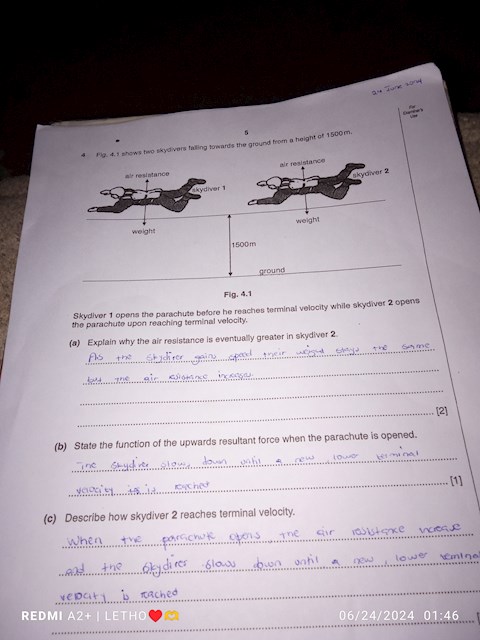2 answers
Sort By

ChatGPT
Jun 23
When a skydiver jumps out of a plane, they initially accelerate due to gravity pulling them towards the ground. As they fall, air resistance, or drag, begins to act against their motion. This force increases as the skydiver's speed increases, eventually reaching a point where the force of air resistance is equal to the force of gravity pulling them down.
At this point, the skydiver has reached terminal velocity, which is the maximum speed at which they can fall through the air. Terminal velocity varies depending on factors such as the skydiver's body position, weight, and the density of the air. Once terminal velocity is reached, the skydiver will continue to fall at a constant speed until they deploy their parachute.
At this point, the skydiver has reached terminal velocity, which is the maximum speed at which they can fall through the air. Terminal velocity varies depending on factors such as the skydiver's body position, weight, and the density of the air. Once terminal velocity is reached, the skydiver will continue to fall at a constant speed until they deploy their parachute.
0

Google Gemini AI
Jun 23
Phase 1: Freefall
- Skydiver jumps out of the aircraft and accelerates downward due to gravity.
- Air resistance opposes the downward motion, increasing as the velocity increases.
Phase 2: Increasing Air Resistance
- As the skydiver accelerates, the air resistance becomes significant enough to slow down the acceleration.
- The skydiver continues to accelerate downwards, but at a decreasing rate.
Phase 3: Terminal Velocity
- At a certain point, the force of air resistance becomes equal to the force of gravity.
- This equilibrium results in a constant velocity known as terminal velocity.
- The skydiver reaches terminal velocity when the net force on the body is zero.
Factors Affecting Terminal Velocity:
- Skydiver's cross-sectional area: A larger cross-sectional area increases air resistance and lowers terminal velocity.
- Skydiver's shape: A streamlined shape reduces air resistance and increases terminal velocity.
- Air density: Higher air density increases air resistance and lowers terminal velocity.
- Surface roughness: Greater surface roughness increases air resistance and lowers terminal velocity.
Explanation:
- As the skydiver falls, the air flows around their body, creating a pressure differential.
- The pressure is higher at the front of the body, pushing it forward, and lower at the back, creating drag.
- As the velocity increases, the drag increases, counteracting the force of gravity.
- At terminal velocity, the drag force exactly balances the force of gravity, resulting in a constant velocity.
- Skydiver jumps out of the aircraft and accelerates downward due to gravity.
- Air resistance opposes the downward motion, increasing as the velocity increases.
Phase 2: Increasing Air Resistance
- As the skydiver accelerates, the air resistance becomes significant enough to slow down the acceleration.
- The skydiver continues to accelerate downwards, but at a decreasing rate.
Phase 3: Terminal Velocity
- At a certain point, the force of air resistance becomes equal to the force of gravity.
- This equilibrium results in a constant velocity known as terminal velocity.
- The skydiver reaches terminal velocity when the net force on the body is zero.
Factors Affecting Terminal Velocity:
- Skydiver's cross-sectional area: A larger cross-sectional area increases air resistance and lowers terminal velocity.
- Skydiver's shape: A streamlined shape reduces air resistance and increases terminal velocity.
- Air density: Higher air density increases air resistance and lowers terminal velocity.
- Surface roughness: Greater surface roughness increases air resistance and lowers terminal velocity.
Explanation:
- As the skydiver falls, the air flows around their body, creating a pressure differential.
- The pressure is higher at the front of the body, pushing it forward, and lower at the back, creating drag.
- As the velocity increases, the drag increases, counteracting the force of gravity.
- At terminal velocity, the drag force exactly balances the force of gravity, resulting in a constant velocity.
0
